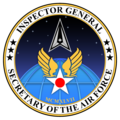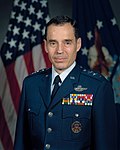| Inspector General of the Department of the Air Force | |
|---|---|
 Seal of the inspector general | |
 Flag of an Air Force lieutenant general | |
| Department of the Air Force Air Staff | |
| Type | Inspector general |
| Abbreviation | DAF/IG |
| Reports to | Secretary of the Air Force |
| Seat | Headquarters Air Force, The Pentagon, Arlington, Virginia |
| Appointer | The president with Senate advice and consent |
| Term length | 4 years |
| Constituting instrument | 10 U.S.C. § 9020 |
| Formation | 1947 |
| First holder | Maj Gen Junius Jones |
| Website | www |
The inspector general of the Department of the Air Force is responsible for conducting investigations and inspections as directed by the secretary of the Air Force, chief of staff of the Air Force, and chief of space operations. The position was originally established after World War II as the air inspector, which was carried over from the United States Army Air Forces. The current mission of the inspector general is prescribed by Title 10 (§ 8020) and Title 32 of the United States Code (§ 105) to develop United States Air Force (USAF) and United States Space Force (USSF) policy to assess readiness, discipline and efficiency with a vision to help shape senior leader decisions affecting the readiness of the USAF and USSF to strengthen the nation's defense.










































